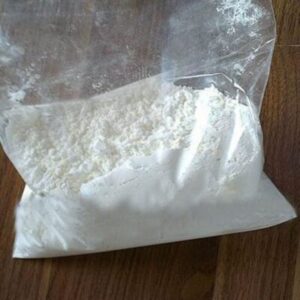Introduction
NM2201 is a synthetic cannabinoid that belongs to the indole-based family of synthetic cannabinoids. It is a potent agonist of the CB1 and CB2 receptors and is known for producing intense psychoactive effects. NM2201 is one of the many synthetic cannabinoids that have emerged in the market over the past decade, and its use has been associated with several adverse health effects.
Chemical Properties
NM2201 has a molecular formula of C24H22FNO2 and a molecular weight of 375.44 g/mol. It is a white crystalline powder that is soluble in organic solvents like methanol, ethanol, and DMSO. NM2201 has a melting point of 213-214°C and a boiling point of 551.4°C at 760 mmHg.
Synthesis
NM2201 is typically synthesized in a laboratory setting using a multi-step process that involves several chemical reactions. The starting materials used in the synthesis of NM2201 are naphthalene-1-yl-(1-pentylindol-3-yl)methanone and 1-(5-fluoropentyl)-1H-indole-3-carboxylic acid. The final product is then purified through recrystallization and characterized using analytical techniques like NMR spectroscopy and mass spectrometry.
Pharmacology
NM2201 exerts its effects by binding to the CB1 and CB2 receptors in the brain and peripheral tissues, leading to a range of psychoactive effects. The effects of NM2201 can vary in intensity and duration depending on the dosage and route of administration. NM2201 is typically consumed by smoking or vaporizing the powder, or by ingesting it in capsules or tablets.
Effects
When consumed, NM2201 can produce a range of psychoactive effects, including euphoria, relaxation, altered perceptions, and heightened sensory experiences. These effects can vary in intensity and duration depending on the dosage and route of administration. NM2201 is also known for producing adverse effects such as anxiety, paranoia, hallucinations, and even psychosis in some cases.
Risks and Side Effects
The use of NM2201 has been associated with several adverse health effects, especially when used in high doses or for prolonged periods. The adverse effects of NM2201 can include tachycardia, hypertension, respiratory depression, nausea, vomiting, seizures, and even death in some cases. Long-term use of NM2201 may also lead to addiction, tolerance, and withdrawal symptoms upon cessation.
Conclusion
In conclusion, NM2201 is a potent synthetic cannabinoid that produces intense psychoactive effects by binding to the CB1 and CB2 receptors in the brain and peripheral tissues. However, it can also pose significant risks to human health, including addiction, tolerance, and withdrawal symptoms, as well as adverse effects such as tachycardia, hypertension, respiratory depression, nausea, vomiting, seizures, and even death. As such, it is important to use NM2201 with caution and under medical supervision.






Reviews
There are no reviews yet.